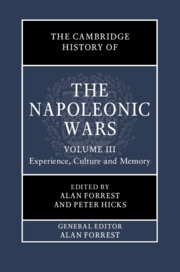Book contents
- The Cambridge History of the Napoleonic Wars
- The Cambridge History of the Napoleonic Wars
- The Cambridge History of the Napoleonic Wars
- Copyright page
- Contents
- Figures
- Maps
- Contributors to Volume III
- Introduction to Volume III
- Part I The Experience of War
- Part II The Experience of Imperial Rule
- Part III War, Culture and Memory
- 12 Memoirs and the Communication of Memory
- 13 Festivals, Ceremonies and Public Commemorations
- 14 The Portrayal of Heroism
- 15 The Fine Arts and the Napoleonic Wars
- 16 Poets and Novelists: Writing the Memory of War
- 17 Political Keyboard Music in Revolutionary and Napoleonic France: ‘The Battle’
- 18 The Napoleonic Wars in Caricature
- 19 The Napoleonic Wars in European Cinema
- 20 Nostalgia, or a Ruin with a View
- Part IV The Aftermath and Legacy of the Wars
- Bibliographic Essays
- Index
15 - The Fine Arts and the Napoleonic Wars
from Part III - War, Culture and Memory
Published online by Cambridge University Press: 05 August 2022
- The Cambridge History of the Napoleonic Wars
- The Cambridge History of the Napoleonic Wars
- The Cambridge History of the Napoleonic Wars
- Copyright page
- Contents
- Figures
- Maps
- Contributors to Volume III
- Introduction to Volume III
- Part I The Experience of War
- Part II The Experience of Imperial Rule
- Part III War, Culture and Memory
- 12 Memoirs and the Communication of Memory
- 13 Festivals, Ceremonies and Public Commemorations
- 14 The Portrayal of Heroism
- 15 The Fine Arts and the Napoleonic Wars
- 16 Poets and Novelists: Writing the Memory of War
- 17 Political Keyboard Music in Revolutionary and Napoleonic France: ‘The Battle’
- 18 The Napoleonic Wars in Caricature
- 19 The Napoleonic Wars in European Cinema
- 20 Nostalgia, or a Ruin with a View
- Part IV The Aftermath and Legacy of the Wars
- Bibliographic Essays
- Index
Summary
Carl von Clausewitz famously asserted that the French Revolution made war ‘the business of the people’.1 Visual depictions of the Napoleonic Wars from the period suggest that something had indeed fundamentally changed: such images were not only more available than ever before to a broad public; they also addressed the interests and desires of far greater numbers of people. The new ways of depicting war varied enormously from country to country, depending on local traditions, art institutions and patronage practices, but across Europe representations of the wars concerned themselves as never before with the plight of the common soldier, the human costs of war, and the definition and advancement of the nation, even in places where the French Revolution seemed to have had little impact. This chapter focuses on the effects of the wars on painting and sculpture, but it also makes clear that the Napoleonic Wars brought the fine arts into a closer dialogue with more popular forms, especially prints, and with ideas of cultural heritage and national patrimony.
- Type
- Chapter
- Information
- The Cambridge History of the Napoleonic Wars , pp. 302 - 327Publisher: Cambridge University PressPrint publication year: 2022

